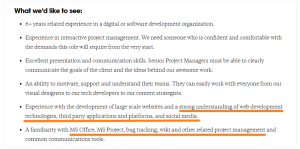
In the early stages of business, CEOs and founders are involved in almost all aspects of a business, from creating budgets to picking out furniture for the office. As the team grows and day-to-day responsibilities are passed off to new employees, the CEO often stays very involved in most decision making processes, whether that’s onboarding new hires or reviewing every marketing campaign before it launches. It’s a usually good thing—the sign of a driven, detail-oriented founder dedicated to getting the company vision off the ground.
As the company scales up and the organization grows bigger and more complex, however, it becomes more difficult for the CEO to maintain that same level of control over the business—and in fact, it may hinder the company’s growth. It’s one of the most difficult transitions CEOs and founders face during scale-up stage: letting go and putting trust in others to get the job done.
Building a culture of trust
Trust can be one of the hardest cultural values to build within a large organization, but it’s worth the effort. Companies with high levels of trust in the workplace tend to have more engaged employees, better employee morale, and lower turnover. Studies have shown that they often outperform companies with lower levels of trust in measures of higher productivity (output per employee), increased profitability, growth rate, and levels of innovation.
Workplace trust starts with a few key foundational principles:
- Employees have a large amount of ownership and autonomy in their work and encouraged to bring new solutions and ideas to the table. Strong leaders trusts the employees to manage people and execute projects in their own way, as long as they continue to meetgoals and expectations.
- Employees feel respected for their time and efforts. They trust leadership will treat everyone as equals (owed respect) but will also reward and acknowledge top performers (earned respect).
- Employees feel psychologically safe. They feel comfortable asking questions, speaking with candor, admitting to mistakes, receiving feedback without harsh criticism, and generally express themselves at work.
- Employees feel connected to a purpose. Employees and leadership trust that they are all working toward a shared common goal or vision.
Building a culture of trust does not happen overnight, nor will it be the result of a half-hearted HR initiative that makes big promises but does little in the way inspiring change. Trust is built over time through actions taken by management and interactions between leaders and employees. As a leader, everything from how you respond to employee requests to how you manage negative performance will impact your overall workplace trust. Here are four important actions to help you cultivate trust in your company:
When appropriate, respond with questions instead of answers.
Most CEOs and managers have the natural instinct to be clear and concise about what they want, and to have an answer to everything. And while this may be productive during the onboarding phase of new employees, it creates a one-sided relationship over the long term where subordinates simply follow orders instead of thinking critically and asking questions. Instead, engage employees by asking open-ended questions.
For example, instead of saying how you would solve a problem, ask your team, “How do you think we should approach this? What might be a better solution than what we’ve done in the past?” Or instead of providing negative feedback, try to probe for clarification and reasoning: “What was the thinking behind the work? How did you arrive at these conclusions?” Over time, this simple practice encourages employees to engage in strategic thinking and to take more initiative in solving problems for themselves. It also makes them feel heard and valued—a huge factor in building trust.
Regularly praise and share examples of excellent work to the entire company.
If you want to get the best out of your team, tell them what they are doing well. Don’t try to formalize praise into some sort of employee-of-the-month program. That can separate the praise itself from the actual work accomplishments. It’s important to describe what the employee did to deserve the recognition.
Instead, turn praise into an informal process that you do regularly. It can be a simple companywide email or simply five minutes spent at the weekly company all-hands. Being specific will help the entire team see what excellence looks like, so that they can replicate it elsewhere and understand expectations. In addition to major accomplishments, be sure to include small wins as well, whether it’s how a customer complaint was handled to a creative way an IT problem was fixed.
Don’t be afraid to be vulnerable.
Google spent years and enormous amounts of resources to find out why some teams perform better than others, and in the end, they discovered that the one thing that high-performing groups had over others was a sense of psychological safety. Teams that felt “safe” with one another felt they could be themselves and take risks and make mistakes without being negatively judged by another member of the group.
As a leader, you can quickly influence a team dynamic simply by being vulnerable. At Google, one manager broke the ice with his team by admitting he had stage 4 cancer. The team, which had previously struggled to jell with one another, opened up with their own personal stories and eventually came to work better together. This doesn’t mean that leaders should share their deepest, most personal secrets at work. It’s simply to reiterate that being vulnerable—admitting mistakes or when you don’t know something, expressing feelings, understanding limitations—all show that you’re authentic and human just like everyone else. Leaders that show vulnerability will encourage employees to do so as well, which ultimately improves the company dynamic all around.
Use delegating moments as teaching moments.
Not many people like micromanagers, but being a hands-off macro manger that simply expects the team to just “get it done” can also be detrimental to a company. It’s important to find a balance between the two styles. As a leader, you need to give enough autonomy to your team so they will want to bring their best while also providing them with enough guidance and feedback that they feel they’re making progress and that their work means something.
A simple tactic is to remember to include the “why” every time you delegate a task. Employees, particularly junior employees, are used to being told how to do things, but including the why helps them to see the bigger picture and how what they’re being asked to do aligns with the company’s strategic plan. The more that management is able to communicate the why, the more aligned the entire organization will be around the company vision.
Make trust a mindful practice
Trust isn’t something that organizations have intrinsically. Leaders looking to build a culture of trust must start with themselves. Think about how your actions and words influence those you lead. Keep in mind that behaviors drive trust, then work to incorporate those behaviors into your daily leadership practice. Lead by example and teach your managers how to do so as well. It will be one of the most impactful changes you can effect in your organization.
Business & Finance Articles on Business 2 Community
(36)







